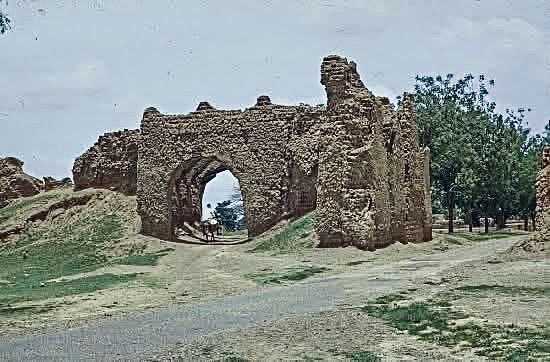By: Abdullahi Inuwa
How an 800-Year-Old Architectural Masterpiece Continues to Tell the Story of a Kingdom, a People, and a Civilization
In 1965, American photographer Elisofon Elliot, one of the most respected documentary photographers of his era, captured an image that would later become an iconic window into the architectural and cultural soul of northern Nigeria. His photograph—sharp, dignified, and elegantly framed—showed a section of the historic Katsina walls and gates, a structure that had already stood for more than 800 years.
Today, that same image remains a powerful reminder of a civilization that flourished long before colonial footprints touched West Africa. It also highlights the extraordinary craftsmanship and urban planning that defined the ancient Katsina Kingdom, one of the oldest continually inhabited political and cultural centres in the region.
The Katsina walls, built primarily from laterite earth and strengthened with traditional binders, were constructed as both a defensive fortress and a symbol of sovereignty. Rising up to 10 meters in some sections, the walls once encircled the entire city—stretching nearly 21 kilometers in circumference.
Along this majestic perimeter sat Katsina’s famous gates, each one a strategic access point used for trade, diplomacy, and military control. The gates were not merely entrances; they were statements of identity. Each bore a name tied to a district, lineage, or strategic function—Kofar Durbi, Kofar Guga, Kofar Kaura, Kofar Marusa, Kofar Kwaya, and others whose historical roles remain deeply etched in community memory.
In the 19th century, travelers described the walls as “massive and imposing,” with thick buttresses and beautifully curved outlines. But Elisofon Elliot’s 1965 photograph brought this ancient infrastructure into the global spotlight. His lens captured not just clay walls, but the quiet confidence of a city that had stood firm through the rise and fall of empires.
The city of Katsina has endured centuries of political transitions—from precolonial Hausa kingdoms to Fulani rule, through colonial occupation and into modern Nigeria. Yet through all these phases, the walls have remained, their longevity testament to the engineering brilliance of Hausa architecture.
Specialists in indigenous architecture note that the walls were designed to adapt to Katsina’s climate, using materials that expand and contract naturally. Their thickness helped keep the city cool, and their height provided a vantage point for surveillance. Combined with the strategic positioning of gates, the system formed a sophisticated urban defense network remarkable for its era.
Beyond their military significance, the walls encircled a city famous for scholarship and commerce. Katsina was a major center of Islamic learning, attracting scholars from across West Africa. The ancient Kusugu Well, the Gobirau Minaret, and historic palaces all sat within the protective embrace of the walls.
Caravans from the Sahara brought salt, cloth, and luxury goods, while local craftsmen traded leather, metalworks, and later, renowned Katsina textiles. The gates served as regulatory points for taxing goods and controlling the movement of travelers and traders.
To walk through one of these gates, historians say, was to enter a world of intellectual prestige, political influence, and commercial vibrancy.
Elisofon Elliot’s interest in African architecture went beyond aesthetics. He believed that structures like the Katsina walls held stories that must be preserved visually. His 1965 photograph became part of a larger body of work documenting the art, architecture, and people of Africa at a time when Western audiences knew little about the depth of African civilizations.
In the photograph, the wall stands sturdy, textured, and sunlit—its shadow bending across the dusty earth. It is a snapshot of permanence in a rapidly changing world, freezing a heritage site at a moment when modernization had not yet threatened its full outline.
Despite their resilience, large portions of the Katsina walls have suffered from erosion, population growth, encroachment, and periods of neglect. Urban expansion has eaten into areas once protected by the ancient fortifications, and climate pressures have added new threats.
The Katsina State Government, alongside cultural conservation advocates, is increasingly being called upon to direct resources toward restoring and preserving the surviving sections. Experts argue that with proper rehabilitation, the walls could qualify as a UNESCO World Heritage Site, bringing both international recognition and tourism benefits to the region.
For the people of Katsina, the walls and gates are more than relics—they are symbols of identity, continuity, and heritage. Festivals, oral histories, and local traditions all reference the gates as key landmarks. Many families trace their ancestry to warriors, scholars, and gatekeepers who once lived within the walled city.
As urban modernization reshapes the landscape, the memory of these walls remains etched in the hearts of the people—reminding them of a time when their city stood at the crossroads of culture, learning, and power.
The 1965 Elisofon photograph is a gift—one that freezes an invaluable piece of history. Today, as Katsina balances development with heritage preservation, that image serves as a call to protect what time has spared.
The ancient walls are not just remnants of architecture.
They are guardians of a story—800 years long—still waiting to be fully told, preserved, and celebrated.
Abdullahi Inuwa Social Commentator ainuwa303@gmail.com




